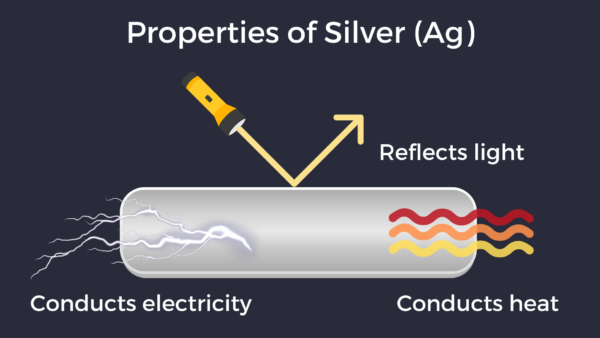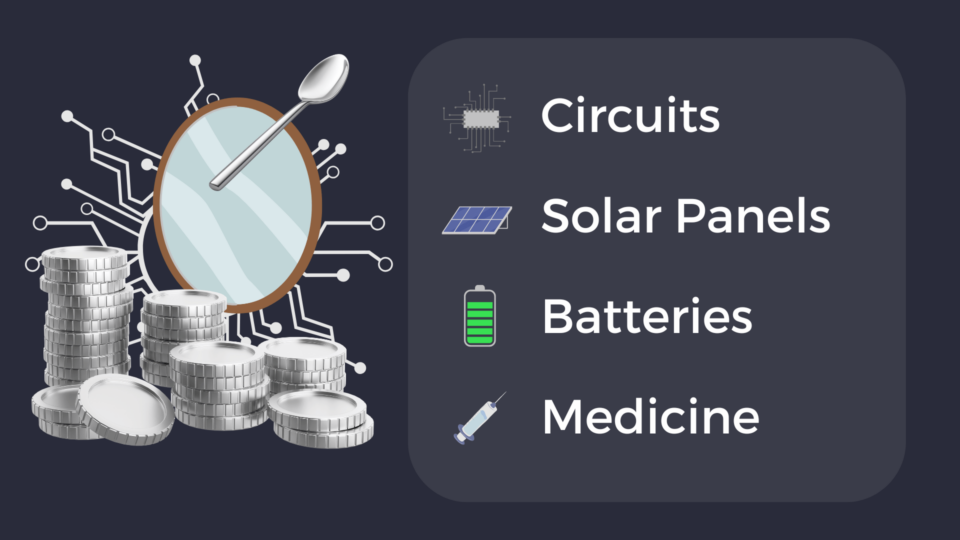Silver is often associated with “second place.” But don’t be fooled: silver is a remarkable metal that often plays a much greater role in our everyday lives than its glamorous yellow counterpart.
Silver Industrial Uses
Since the dawn of civilization, silver has flexed its value in currency, jewelry, silverware, cultural and religious artifacts, trophies, musical instruments, and much more.
Here are a few properties that make silver so useful and unique:
- Electric Conductivity: Electric current flows through it efficiently
- Thermal Conductivity: Heat energy can be quickly transferred through it
- Reflectivity: It reflects, or “bounces back,” a significant portion of incident light (This is why when asked, “What color is a mirror?” you might answer, “Silver!”)
- Antimicrobial: It inhibits the growth of bacteria, viruses, and other pathogens, helping to prevent infections and disease

Powering Connectivity
If you own a computer, gaming console, cell phone, or electric appliance, you own some silver.
Over 50% of global silver consumption is attributed to the electronics sector, where it is used to manufacture printed circuit boards, semiconductors, and electrical contacts.
“Electrical contact” refers to the point of physical connection between two conductive materials. Silver enables electrons to flow from one material to the other in an electrical circuit. Its conductivity ensures minimal loss of energy during transmission, thus making our devices more efficient and reliable.
Silver oxide and silver-zinc batteries are used in devices such as hearing aids and watches.
Harnessing Clean Energy
Electric vehicles are poised to take the place of gas-powered vehicles.
The EU plans to phase out the sale of new gas-powered cars and trucks by 2035. In the United States, there is an ongoing proposal in Congress to ensure that over two-thirds of new car sales are electric by 2032.
Whether or not you agree with these legislative moves, they undoubtedly paint a promising future for silver.
EVs use lithium-ion batteries made from rare earth minerals such as lithium, nickel, cobalt, manganese, and graphite. But they also depend heavily on silver for its electric and thermal conductivity.
Silver’s reflective properties have also found a niche in the rapidly growing solar energy sector, particularly in the production of photovoltaic cells (devices that convert sunlight into electricity).
With the increasing shift toward electric vehicles and renewable energy, the demand for silver is on the rise.
Protecting and Healing
Silver has a rich legacy in medicine dating back thousands of years. Ancient Egyptians, Greeks, Phoenicians, and Romans all harnessed silver’s antimicrobial attributes by applying it directly to wounds to improve healing. Silver coins were often dropped into water and wine casks to keep the liquids fresh on long treks and ocean voyages.
During World War I, battlefield wounds were wrapped in silver foil and silver sutures were used to close deep wounds. In the late 1800s, doctors gave newborn babies several drops of silver nitrate in their eyes to prevent neonatal conjunctivitis.
Nowadays, breathing tubes and catheters are coated with silver. The metal is also used in bandages and ointments to prevent bacterial infections and help the body heal faster.
But how does silver actually fight pathogens? The science is fascinating and terrifying, especially if you’re the bad guy.
First, silver ions puncture the cell membranes of bacteria and bind to enzymes, proteins, and DNA within the cell, disrupting essential functions and leading to bacterial death. Next, the dead cell collects reservoirs of silver nanoparticles which then leach out into the environment, making contact with other bacteria and repeating the process. In other words, silver can turn a group of pathogens into an army of bacteria-killing zombie cells. It’s truly astonishing!
Silver is effective against antibiotic-resistant bacteria such as MRSA (Methicillin-resistant Staphylococcus aureus). Hospitals are fighting it by using silver-imbedded surgical tools, needles, stethoscopes, furniture, door handles, furniture, linens, and even paper files.
What does this mean for investors?
Silver always has been – and always will be – one of the most important metals in the world. However, its industrial demand ebbs and flows.
During the robust growth of the 1990s, industrial silver demand increased by approximately 60% (from 500 million troy oz in 1990 to 800 million troy oz in 1999). In that time, silver outperformed gold by over 42%, causing a significant drop in the gold/silver ratio.
This demand came primarily from photography, silverware, and batteries.
Industrial demand has been flat for the last decade, which is part of the reason gold has vastly outperformed silver.
However, the tide is beginning to shift in silver’s favor once again. As silver demand increases for technological and industrial applications, its value will follow. The earth’s supply of silver is finite. Unlike fiat currency, we cannot simply print more.
A Sustainable Bull Market
Silver is known for its extreme volatility and explosive bull markets.
From 1971 to 1980, the price of silver increased from $1.28/oz to a peak of $48.00/oz (an incredible 3,627% increase). However, by June of 1982, the price had fallen back to $4.89/oz.
From 2008 to 2011, silver spiked from $8.45 to $49.83 (a 490% increase). Once again, most of the gains were lost in the following years.
This kind of volatility is not ideal for long-term investors. Fortunately, a healthy increase in industrial demand is likely to create sustainable returns and high prices over the long run instead of crazy speculative spikes.
We believe the resurgance of silver demand will make the precious metal an excellent bet for long-term investors in the coming years.
Start Investing With Vaulted Silver
Vaulted Silver is the easiest way to own a piece of the future. You can purchase real silver with just a few taps on your Vaulted app.
You will own real, physical silver without having to store it yourself. Vaulted Silver allocates serial-numbered silver bars to your account, safely stored in a world-class vault.
You’ll never pay more than you should for your precious metals when you buy them through Vaulted. The premiums for physical silver are just 2% over our wholesale cost — 10 times less than what you might pay through a traditional precious metals dealer.
You can buy and sell your silver at will securely through the Vaulted app.













